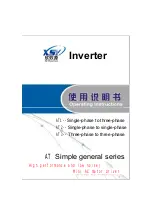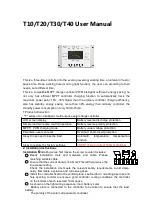
February 2020
|
Solar Stik
®
, Inc.
60
|
System Setup and Operation Manual for ATSC MS3 L0
PRO-Verter Charger Problems: Solutions and Explanations
Unit won’t transfer to Charge mode when connected to generator or grid AC
Solution:
Is the charge (CHG) LED on the User Interface blinking? If not, the charger does not
recognize the incoming AC as being within acceptable limits. Disconnect the AC input cable from
the PRO-Verter. Measure the voltage at the cable terminals—it should be 230 VAC +/- 20 VAC). Also,
check that the SETUP 03B VAC Dropout setting on the User Interface is “UPS Mode”. If the CHG
LED is blinking, the transfer relay should close within 20 seconds and begin charging. If the LED is
on solid, the relay should be closed and the charger should begin charging.
Transfer relay closes, then opens and continues to cycle
Solution:
Input voltage is too low or has transients that drop the voltage momentarily. Change the
SETUP 03B VAC Dropout setting to 180 VAC and check for improvements. If the cycling continues,
back off the charge rate from 100% to 10% (or “OFF”, if available). This cycling may also be caused
if the AC output of the inverter is connected to the inverter’s AC input. Check for proper input and
output AC wiring.
Charger not charging even though Charge LED is on steady and the unit says “Charging”
Solution:
Full charge rates are not obtained in Charging mode. Full charge rates will occur only after
this mode changes to Bulk charging, Absorb charging, or Float charging modes.
Charger not charging even though Charge LED is on steady and the unit says “Bulk Charging”
(or “Absorb Charging”)
Solution:
Check the METER 01A DC Volts and METER 01B DC Amps meter values on the LCD
screen. It should be close to the maximum rated (or programmed) charge current if the battery
voltage is under 28.0 VDC on 24-volt models. Check the Meter SETUP 03A AC Input Amps setting
and ensure that it is set in accordance with system requirements.
Charger says “Float Charging” not “Bulk Charging” when the AC is first plugged in
Solution:
Check the METER 01A DC Volts meter on the LCD screen. If the battery is > 26.0 VDC
then the battery was already charged and the charger automatically goes to Float charging to keep
from overcharging the batteries.
Charge amps are lower than expected, or is 0 amps DC
Solution:
The charge rate may have been reduced to keep the input voltage above 150 VAC.
Measure input voltage and increase it if the input voltage is under 150 VAC. Also, check the 03A AC
Input Amps and SETUP 03E Max Charge Rate settings to determine if the current is being limited.
Charger output voltage is different than expected
Solution:
Check the Battery Temperature Sensor (BTS) temperature. The charge voltage settings
will increase if the temperature around the BTS is below 77 °F (25 °C) or decrease if the temperature
around the BTS is higher than 77 °F (25 °C). The BTS is located inside of the PRO-Verter.
















































